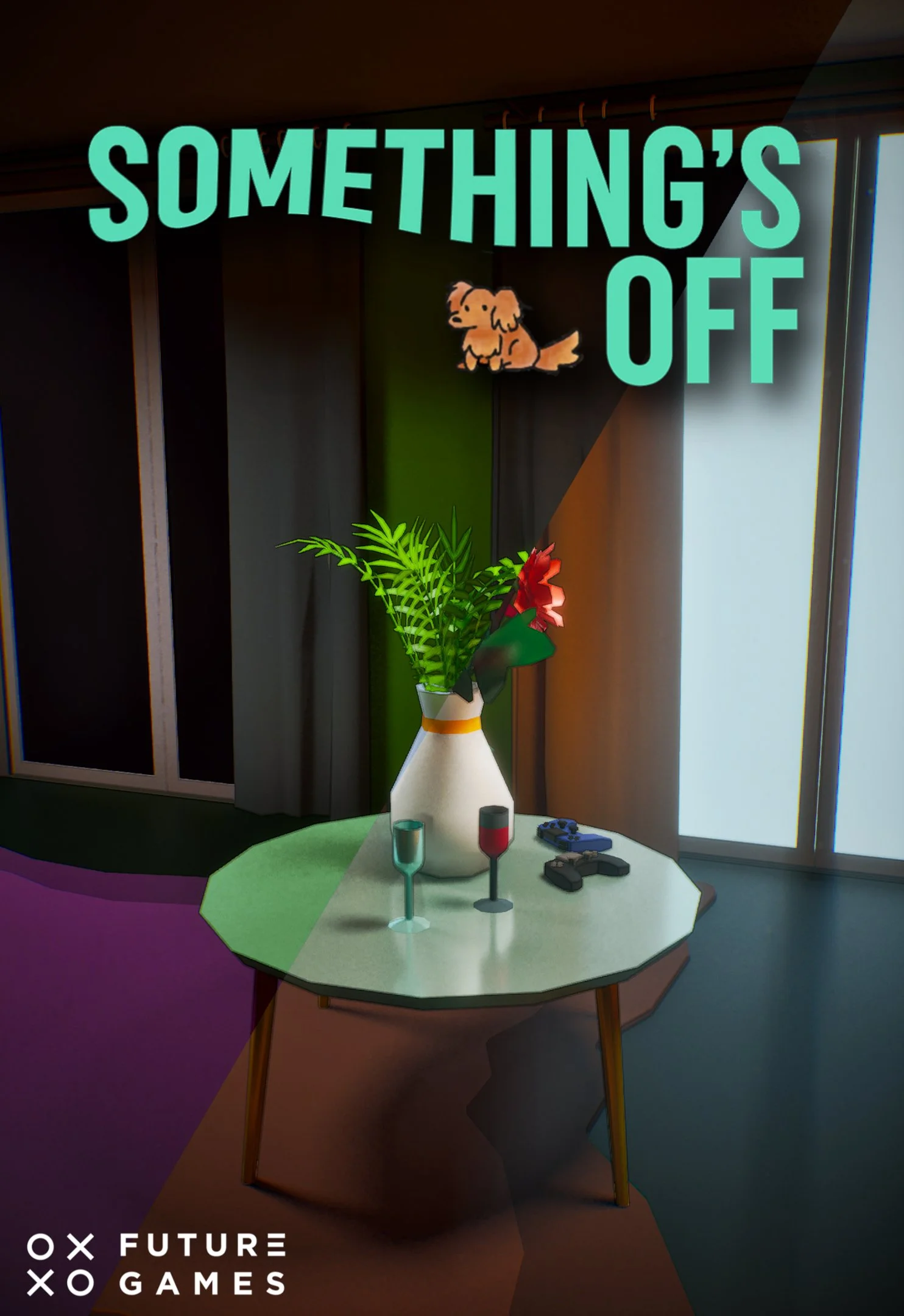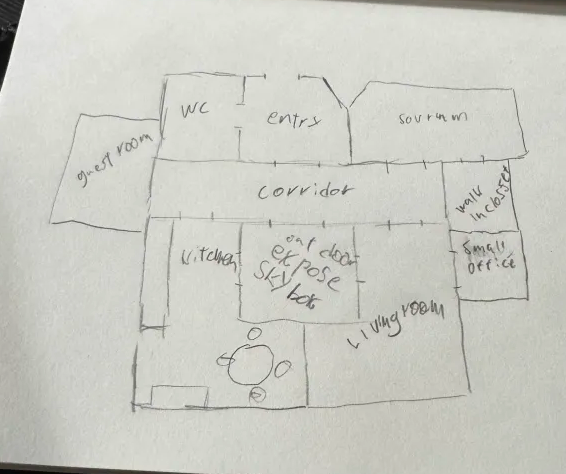Something’s off
Can you find all Anomalies?
Something's Off is a spot-the-difference game where you play as a house broker. At night, subtle changes appear in the properties, and your task is to document them by comparing photos from daytime visits to the current state.
Developed as a four-week Unreal Engine project with a team of 6, this vertical slice helped me improve level design, pacing, and environmental storytelling.
I contributed as a level designer by
Creating the two main playable levels and the tutorial
Designing believable spaces and maintaining a coherent art style
Decorating levels and adding environmental storytelling elements
Implementing visual scripting systems such as the shop transition
Adding interactive easter eggs and gathering assets
Trailer creation
This project allowed me to combine gameplay, narrative, and environment design while sharpening my practical Unreal Engine skills.
Watch the trailer!
My work
I was one of four game designers on a six-person team, working alongside two programmers. I focused on level design, content creation, and helping define the game’s overall structure.
I worked on designing and setting up the main level layout, focusing on guiding the player through the environment in a natural and intuitive way. I also created several of the “anomalies,” experimenting with environmental storytelling and small gameplay twists.
I was actively involved in writing our Game Design Document (GDD). Since our team had no dedicated artists, it was important to define goals and features clearly from the start. I also wrote the main premise and setting for the game. Even though it was not perfect, it helped us establish the game loop and overall direction early in development.
Throughout the project, I designed four levels, decorating two of them and filling them with gameplay content. Our main level alone features around 100 anomalies that players must find and identify as part of the core gameplay. Two anomalies that I personally created were a coin that flips randomly using only physics, producing the perfect flip with a satisfying sound for nearby players, and a lamp that plays a morse code message by turning on and off in a specific sequence. The morse code was a fun joke referencing our producer and can easily be repurposed in future projects.
I also created a number of subtle easter eggs that only some players might notice. For example, during transitions in our shop menu, a camera pans from one bulletin board to another. Between the boards, you can see an office, and certain details in that office have a small chance to change each time the transition occurs.
I created all of the game’s sounds, sourcing clean, distortion-free audio and doing light editing to make them fit seamlessly in the game. On top of that, I created the game trailer using tools inside the engine and external video editing software. I also helped with testing and balancing to make sure the pacing across levels felt smooth and engaging from start to finish.
Here are some beauty shots from the final level
Here is a short video showcasing the prototype level.
This is the morse code lamp i created in blueprints
Level design
For the level design, my goal was to create somewhat believable apartments. Since we had no 3D or VFX artists, I pushed early on for a low-poly aesthetic, which gave the game a stylized, cartoony look.
I started each level with a paper sketch to nail the size of the level and rooms as early as possible. After a quick review with the team, I immediately began the blockout in Unreal Engine. I used a stock Unreal character model to keep sizes consistent and created door frames as actors to maintain scale throughout the levels. This also let me test gameplay elements like travel distance between rooms, ensuring the game didn’t feel slow even when players spent time in the same area.
Blocking out the levels was a fast process. Everything was built directly in-engine and became the foundation for the final levels. Due to the short project timeline, the blockouts themselves became playable after some polish.
By the halfway point, we decided to cut our largest level. Although the blockout was complete, filling it with the same level of detail as the main level would have taken too much time. This was the right decision for the project, and after that, I focused fully on refining every detail in the main level. Once satisfied, I began placing final assets, replacing reference objects with purchased assets that fit the project.
Getting the scale right remained important, so I frequently compared furniture and objects to real-life dimensions. With the low-poly approach, some exaggeration was possible without breaking immersion.
As the level took shape, I began thinking about the story embedded in the environment. I created an apartment for a couple, slowly revealing a dark story as the player explored, with subtle changes that made things feel off. Unfortunately, I did not have time to decorate the second level, but I would have applied the same narrative approach.
One fun easter egg was inspired by my own experience living in one of the most depressing student apartments in Skellefteå. The tutorial level is a memory-based replica of that room. This gave players a confined space to spot objects easily while adding a personal touch. By chance, our available assets matched the tone of the room very well, making it feel uncanny yet believable.
This was the original sketch for what would be the layout
This is the begining of the blockout
Challenges
This project presented several challenges, but our small team managed to communicate effectively and find solutions together. One of the main challenges was working without dedicated artists or VFX specialists. This meant I had to make early decisions about low-poly aesthetics, scale, and level readability to ensure the game looked coherent and playable.
Time constraints were another challenge. We had to cut our largest level halfway through the project, which required re-focusing our efforts on the main level and making tough decisions about what content to prioritize.
Balancing the gameplay was also tricky, especially with our anomalies. Some were more unpredictable or required precise timing, like the flipping coin, and testing them extensively was important to make sure the experience was fun without being frustrating.
On top of that, creating all the sounds and the game trailer added extra responsibilities, so time management and clear task division were essential to keep the project on track.
If I were to improve the core game now, I would focus on better balancing some anomalies and adding quality-of-life fixes to make the gameplay smoother. Overall, the project taught me a lot about problem-solving, iteration, and collaborating in a small, cross-functional team.
Reflection
Looking back at this project, I think it is where I’ve learned the most. I had a wonderful time working with a great team, and like all school projects, I would have loved to do even more, but time was limited. This is probably the most finished game I’ve worked on so far.
I also feel that this project is where Unreal really started to click for me. It is an incredibly powerful tool, and I now better understand how much can be accomplished inside the engine.
I can easily imagine this game with a full team, but given the resources we had, I am impressed with what my team and I managed to create. I am very proud of the final result.
Because I got to work on multiple aspects of the project, I had the chance to do a little of everything. While level design was my main focus, placing small fun details and making the spaces feel believable was both challenging and rewarding. Designing levels that felt alive and guided the player naturally taught me a lot about pacing, storytelling, and iterative design.






